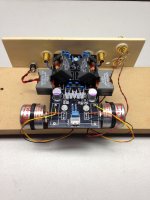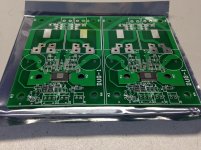Common-mode noise reduction is my working hypothesis for why trafos improve the sound. If all interconnects were balanced then maybe there'd not be room for improvement.
Indeed, not sure why the hi-fi community has such a preference for unbalanced - there is a reason pro audio (and any high-speed data connections) is all balanced/differential. But it doesn't require a transformer...
I have a theory for why unbalanced is the norm in the hi-fi world - to gain bigger retail margins through sales of all kinds of cables at enormous mark-ups.
You could very well be right.
That is fine as long as the DC is a temporary condition. A transformer is not a good solution if you have a permanent DC offset, as the DC biases the transformer and can cause unsymmetrical distortion.
.
DC signals: Fully agree with your statement that DC should be temporarycondition because otherwise transformer saturation wil occur.
Last edited:
I've been using a TPA3116D2 Class D power amp with CineMag CMLI-15B 15k:15k input transformers for several months now, and I have not had problems with the DC bias as the differential inputs balance out. I chose this route to improve common-mode noise reduction and to gauge the effects of removing input capacitors from the signal. Not only is the amp quieter, but the sound quality is significantly improved compared to using input caps in single-ended mode. I have no power-on/power-off thumps either. Some people are a bit cynical about the fact that I paid more money for the input transformers than the Class D amp and all its other upgrades combined, but I have a <$200 Class D amp (including modified Astron RS-12A regulated linear power supply) that has demonstrated to be equal to or better than power amps costing much more--tube and SS.

I plan on building a similar amp with input transformers using DUG's group buy TPA3116D2 PBTL boards. I can't wait to compare this to my current Class D amp in my system.

In terms of Class D vs. tube, I prefer to combine a good tube preamp with my Class D power amp to get excellent sound quality. I pair my TPA3116D2 amp with my Audio Research LS7 line stage and Audio Research PH5 phono stage tube preamps. The synergy with pairing the TI Class D amps with tube preamps has been covered by many in other audio forums, and the majority of those who have tried this combination prefer it.
I'm not married to any amp types or designs. If the circuit is a good design and it is implemented with the right system setup, the sound will be good. I've heard great solid state and great tube amps, and poor ones of each as well. To get the most out Class D amps with high efficiencies, paying attention to the power supply path pays the highest dividends.

I plan on building a similar amp with input transformers using DUG's group buy TPA3116D2 PBTL boards. I can't wait to compare this to my current Class D amp in my system.

In terms of Class D vs. tube, I prefer to combine a good tube preamp with my Class D power amp to get excellent sound quality. I pair my TPA3116D2 amp with my Audio Research LS7 line stage and Audio Research PH5 phono stage tube preamps. The synergy with pairing the TI Class D amps with tube preamps has been covered by many in other audio forums, and the majority of those who have tried this combination prefer it.
I'm not married to any amp types or designs. If the circuit is a good design and it is implemented with the right system setup, the sound will be good. I've heard great solid state and great tube amps, and poor ones of each as well. To get the most out Class D amps with high efficiencies, paying attention to the power supply path pays the highest dividends.
Not only is the amp quieter, but the sound quality is significantly improved compared to using input caps in single-ended mode.
Have you tried using the TPA3116D2in differential/balanced mode without the transformer?
If you mean some other means of converting from single ended inputs to differential inputs, then my answer is no. Texas Instruments has some white papers on this including the use of op amps. Among most pro audio engineers, using transformers for converting unbalanced to balanced signals is the preferred method, so I decided to explore this route first. I've been so satisfied with the results, I haven't really been compelled to investigate anything further. Matt Garman sent me his pair of less expensive Edcor input transformers to try with the TPA3116D2 amp, but I haven't tried them yet. I will post my impressions once I do.
As I mentioned before, the biggest gains with the TPA3116 come from working on the power supply path. Selecting or building a high quality power supply followed with using good DC decoupling caps, good bootstrap caps and implementing the bootstrap snubber circuit made the most significant improvements. Next, replacing the output filter inductors with higher current capacity, lower DCR inductors further improved the sound quality. The use of input transformers was a personal choice for me. For others, the expense may not be worth it. To my ears and with my system, I wanted to bring the Class D amp to a level of performance commensurate with the rest of my system.
As I mentioned before, the biggest gains with the TPA3116 come from working on the power supply path. Selecting or building a high quality power supply followed with using good DC decoupling caps, good bootstrap caps and implementing the bootstrap snubber circuit made the most significant improvements. Next, replacing the output filter inductors with higher current capacity, lower DCR inductors further improved the sound quality. The use of input transformers was a personal choice for me. For others, the expense may not be worth it. To my ears and with my system, I wanted to bring the Class D amp to a level of performance commensurate with the rest of my system.
Last edited:
If you mean some other means of converting from single ended inputs to differential inputs, then my answer is no. Texas Instruments has some white papers on this including the use of op amps.
The TPA3116D2 has differential/balanced inputs, so no op-amps are needed.
No, among most pro audio engineers, using gear with balanced/differential inputs is the preferred method. It is only if you have to deal with gear that only has a single-ended input that they resort to transformers.Among most pro audio engineers, using transformers for converting unbalanced to balanced signals is the preferred method, so I decided to explore this route first.
I switched to a class d audio cda 258 from an nad 275 bee several months ago. The class d has more punch. It's quick and plush. No harsh highs and is consistent across sources. In short a highly competent amp. At this point I feel I could only improve substantially with other speakers or perhaps a class a amp. One could spend thousands and gain little at this level.
I really need to attend one of the regional diy gatherings now to hear whats out there. The high end shops have been under whelming.
I really need to attend one of the regional diy gatherings now to hear whats out there. The high end shops have been under whelming.
- Status
- This old topic is closed. If you want to reopen this topic, contact a moderator using the "Report Post" button.
- Home
- Amplifiers
- Class D
- The sound of class D compared to S'S or tubes